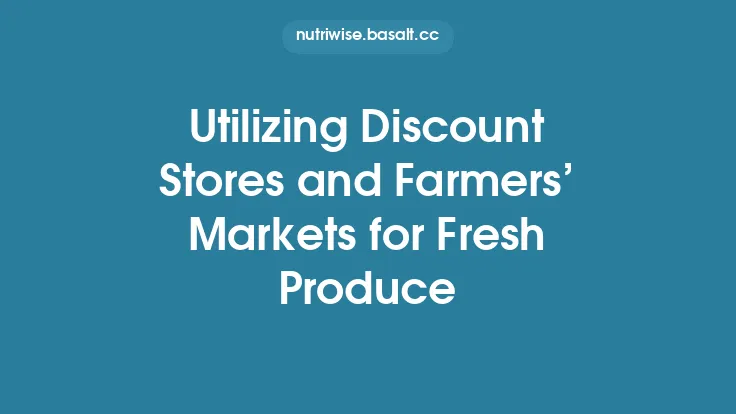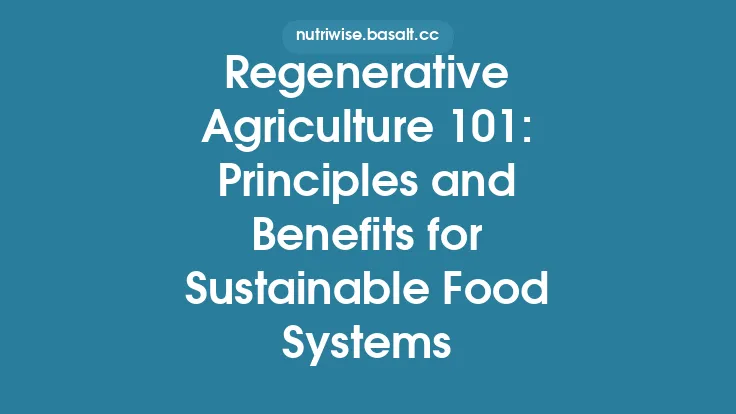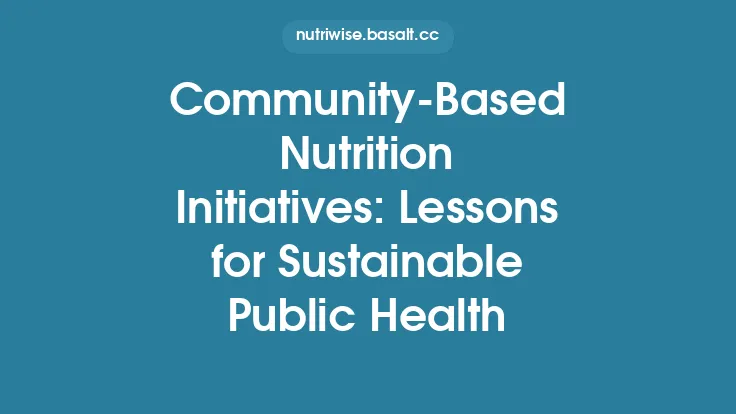Farmers’ markets have become a familiar fixture in towns and cities across the globe, offering a vibrant alternative to conventional grocery stores. While the colorful stalls and the buzz of conversation draw many visitors, the deeper value of these markets extends far beyond the simple act of buying fresh produce. By connecting consumers directly with the people who grow their food, farmers’ markets create a cascade of health‑related and community‑strengthening benefits that endure year after year.
Health Benefits of Shopping at Farmers’ Markets
Nutrient Retention Through Minimal Post‑Harvest Time
Produce sold at farmers’ markets typically reaches the consumer within hours to a few days after harvest. This short interval dramatically reduces the degradation of labile nutrients such as vitamin C, folate, and certain phytonutrients that are sensitive to prolonged storage and transport. Studies have shown that the concentration of these compounds can decline by up to 30 % after a week of refrigerated storage, whereas market‑fresh items retain a higher proportion of their original nutritional profile.
Reduced Exposure to Synthetic Pesticides and Antibiotics
Many market vendors adhere to organic or low‑input farming practices, either by choice or due to the expectations of a health‑conscious clientele. Even when conventional methods are used, the direct relationship between farmer and buyer encourages transparency about pesticide regimes and animal husbandry practices. Consumers can ask specific questions about spray schedules, integrated pest management (IPM) strategies, or antibiotic use, allowing them to make informed decisions that may lower their cumulative exposure to synthetic chemicals.
Greater Dietary Diversity and Micronutrient Variety
Farmers’ markets often showcase heirloom varieties, specialty greens, and region‑specific fruits that are rarely stocked in large‑scale supermarkets. This diversity introduces a broader spectrum of micronutrients and bioactive compounds into the diet. For example, the inclusion of purple carrots (rich in anthocyanins) or red-fleshed apples (high in polyphenols) can enhance antioxidant intake without requiring a deliberate “superfood” search.
Lower Risk of Foodborne Illness Through Traceability
Because the supply chain is short, any contamination event can be traced back to a single farm quickly. This rapid traceability enables swift recalls and targeted interventions, reducing the overall risk of widespread foodborne outbreaks. Moreover, many vendors practice on‑site washing and handling protocols that meet or exceed local health department standards.
Community Building and Social Capital
A Physical Hub for Interpersonal Interaction
Farmers’ markets serve as informal gathering places where neighbors meet, exchange stories, and build relationships. Regular attendance fosters a sense of belonging and creates a network of social support that has been linked to improved mental health outcomes, such as reduced stress and lower rates of depression.
Preservation of Local Culture and Culinary Heritage
Vendors often bring with them traditional recipes, cooking methods, and cultural narratives tied to the crops they grow. Demonstrations, storytelling, and shared meals at market events help preserve regional foodways and pass them on to younger generations, reinforcing cultural identity.
Strengthening Civic Engagement
Market organizers frequently collaborate with local governments, non‑profits, and community groups to address broader issues like food insecurity, public health, and environmental stewardship. This collaborative model encourages citizens to participate in local decision‑making processes, thereby enhancing democratic engagement.
Economic Impact on Local Economies
Multiplier Effect of Direct Spending
When consumers purchase directly from farmers, a larger share of the transaction stays within the local economy. Economic multipliers for farmers’ markets range from 1.5 to 2.5, meaning that each dollar spent can generate up to $2.50 in additional economic activity through wages, local services, and reinvestment.
Job Creation and Entrepreneurial Opportunities
Beyond the growers themselves, markets create ancillary jobs in logistics, marketing, food preparation, and event management. Small‑scale producers can test new products with lower overhead, fostering entrepreneurship and innovation in the agricultural sector.
Resilience Against Global Market Fluctuations
Local food systems are less vulnerable to international price volatility, trade disruptions, or supply chain bottlenecks. By diversifying the sources of food within a community, farmers’ markets contribute to economic stability and food security.
Environmental Advantages of Local Food Hubs
Reduced Transportation Emissions
Shorter “food miles” translate into lower fuel consumption and greenhouse gas emissions. While the exact carbon savings depend on the mode of transport and the type of produce, analyses consistently show that direct‑to‑consumer sales can cut emissions by 20–40 % compared with conventional supermarket distribution.
Promotion of Sustainable Farming Practices
Many market vendors employ regenerative techniques such as cover cropping, reduced tillage, and diversified crop rotations. These practices improve soil organic matter, increase water infiltration, and sequester carbon, contributing to long‑term ecosystem health.
Biodiversity Conservation
By supporting a mosaic of small farms, markets help maintain agricultural biodiversity. Heirloom varieties and niche crops that might be unprofitable at scale are preserved, safeguarding genetic resources that could be vital for future breeding programs and climate adaptation.
Food Access and Equity
Bridging Gaps in Food Deserts
Strategically placed markets in underserved neighborhoods can provide fresh, affordable produce where supermarkets are absent. Partnerships with SNAP (Supplemental Nutrition Assistance Program) and WIC (Women, Infants, and Children) enable low‑income families to purchase market goods, directly addressing nutritional disparities.
Community-Supported Agriculture (CSA) Integration
Some markets host CSA pick‑up points, allowing members to receive regular shares of farm produce. This model spreads the cost of production across many households, making high‑quality food more financially accessible.
Educational Outreach for Nutritional Literacy
Market events often include nutrition workshops, cooking demos, and informational signage that empower consumers to make healthier choices. By demystifying unfamiliar produce, markets reduce barriers to incorporating a wider array of foods into daily diets.
Education and Culinary Skills Development
Hands‑On Learning Opportunities
Direct interaction with growers provides a unique educational platform. Consumers can learn about soil health, pollinator importance, and post‑harvest handling, fostering a deeper appreciation for the food system.
Skill Transfer Through Demonstrations
While the article avoids detailed cooking tips, market demonstrations often showcase basic preparation techniques—such as proper washing, storage, and simple flavor pairings—that enhance confidence in using fresh ingredients.
Youth Engagement Programs
Many markets partner with schools and youth organizations to host field trips, gardening workshops, and “farm‑to‑classroom” activities. Early exposure cultivates lifelong healthy eating habits and may inspire future careers in agriculture or nutrition.
Policy and Infrastructure Supporting Farmers’ Markets
Municipal Incentives and Permitting
Cities that streamline vendor licensing, provide low‑cost stall spaces, and offer tax incentives encourage market growth. Zoning policies that allocate public spaces for regular market days are essential for long‑term viability.
Funding Mechanisms and Grants
Federal and state programs, such as the USDA’s Farmers Market Promotion Program, allocate grants for market development, infrastructure upgrades (e.g., refrigeration, waste management), and outreach initiatives.
Integration with Public Transportation
Coordinating market locations with bus routes, bike lanes, and pedestrian pathways improves accessibility, especially for those without private vehicles, thereby expanding the market’s reach.
Challenges and Opportunities for the Future
Seasonal Limitations and Consumer Expectations
While markets excel in offering fresh, seasonal produce, consumer demand for year‑round availability can pressure vendors to import out‑of‑season items, potentially diluting the local focus. Innovative solutions—such as cold‑storage cooperatives and regional aggregation points—can extend the selling season without compromising locality.
Price Perception and Affordability
Perceived higher costs can deter price‑sensitive shoppers. Transparent pricing models, bulk‑sale discounts, and loyalty programs can mitigate this barrier while maintaining fair compensation for producers.
Vendor Diversity and Inclusion
Ensuring representation of minority‑owned farms and a variety of product categories (e.g., dairy, meat, artisanal goods) enriches the market experience and promotes equity within the agricultural sector.
Technological Integration
Digital platforms for pre‑ordering, mobile payments, and real‑time inventory updates enhance convenience and attract a broader demographic, especially younger consumers accustomed to online shopping.
Practical Tips for Maximizing Your Farmers’ Market Experience
- Plan Ahead – Review the market’s vendor list (often posted online) to identify stalls offering the items you need. This reduces impulse purchases and helps you allocate your budget efficiently.
- Ask Informed Questions – Inquire about the farm’s growing practices, harvest dates, and storage methods. Understanding these details can guide your selection of the freshest, most nutrient‑dense produce.
- Bring Reusable Gear – Use cloth bags, insulated coolers, and reusable produce bags to keep items fresh and reduce waste.
- Sample Strategically – Many vendors provide small tastings. Use these opportunities to discover new varieties and assess flavor before committing to a purchase.
- Leverage Community Programs – Check for SNAP matching programs, “double‑up” days, or free nutrition workshops that can stretch your dollars and expand your knowledge.
- Support Seasonal Variety – Embrace the rotating inventory; it encourages a more diverse diet and aligns your meals with the natural growing cycle.
- Build Relationships – Regular interaction with growers can lead to personalized recommendations, early access to limited‑edition crops, and a deeper sense of community belonging.
Farmers’ markets are more than a venue for buying fresh fruits and vegetables; they are dynamic ecosystems that intertwine health, economics, environment, and social cohesion. By understanding and engaging with these markets, individuals not only enhance their own well‑being but also contribute to the resilience and vitality of their broader community.





